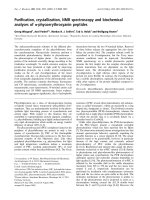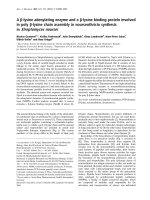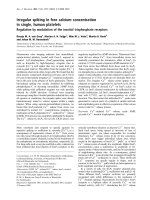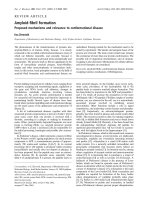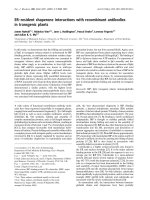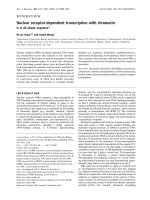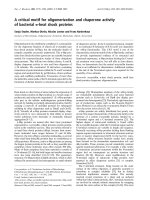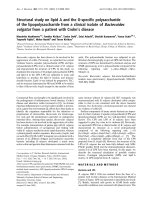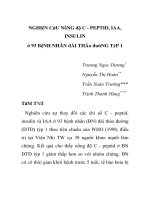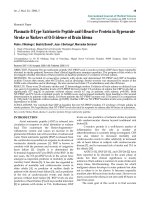Báo cáo y học: " Young adult obese subjects with and without insulin resistance: what is the role of chronic inflammation and how to weigh it non-invasively" docx
Bạn đang xem bản rút gọn của tài liệu. Xem và tải ngay bản đầy đủ của tài liệu tại đây (429.99 KB, 6 trang )
BioMed Central
Page 1 of 6
(page number not for citation purposes)
Journal of Inflammation
Open Access
Research
Young adult obese subjects with and without insulin resistance:
what is the role of chronic inflammation and how to weigh it
non-invasively?
Giovanni Tarantino*
1
, Patrizia Colicchio
1
, Paolo Conca
1
, Carmine Finelli
1
,
Matteo Nicola Dario Di Minno
1
, Marianna Tarantino
2
, Domenico Capone
3
and Fabrizio Pasanisi
1
Address:
1
Department of Clinical and Experimental Medicine, Federico II University Medical School of Naples, Italy,
2
Department of
Biomorphological and Functional Sciences, Federico II University Medical School of Naples, Italy and
3
Department of Neurosciences, Unit of
Clinical Pharmacology, Federico II University Medical School of Naples, Italy
Email: Giovanni Tarantino* - ; Patrizia Colicchio - ; Paolo Conca - ;
Carmine Finelli - ; Matteo Nicola Dario Di Minno - ; Marianna Tarantino - ;
Domenico Capone - ; Fabrizio Pasanisi -
* Corresponding author
Abstract
Background: Obesity is a leading risk factor for metabolic syndrome whose further expression is non-alcoholic fatty
liver disease. Metabolic syndrome is associated with a proinflammatory state that contributes to insulin resistance. Finally,
a "metabolically benign obesity" that is not accompanied by insulin resistance has recently been postulated to exist.
Aim: To find whether any inflammation markers were independently associated with the presence of insulin resistance,
evaluating specific anthropometric, ultrasonographic and laboratory parameters in a population of young adult obese
subjects.
Methods: Of forty two young individuals, divided into two groups (with or without insulin resistance), were studied
serum C-reactive protein and fibrinogen as indexes of chronic pro-inflammatory status. Body mass index, waist
circumference and metabolic syndrome presence were assessed as part of the metabolic evaluation. Ultrasonography
weighted visceral and subcutaneous abdominal fat thickness, spleen size as longitudinal diameter and liver
hyperechogenicity.
Results and Discussion: Serum C-reactive protein and fibrinogen as well as spleen longitudinal diameter were
significantly increased in the obese young with insulin resistance compared to non-insulin resistance group. Insulin
resistance was significantly associated with hepatic steatosis score at sonography (r = 0.33, P = 0.03), spleen longitudinal
diameter (r = 0.35, P = 0.02) and C-reactive protein (r = 0.38, P = 0.01), but not with body mass index, visceral or
subcutaneous abdominal adipose tissue, waist circumference and fibrinogen (P = 0.18, 0.46, 0.33, 0.37 and 0.4,
respectively). Steatosis score at sonography was well associated with spleen volume (rho = 0.40, P = 0.01) and C-reactive
protein levels (rho = 0.49, P = 0.002). Metabolic syndrome was much more frequent in obese patients with insulin
resistance. These findings show that in young adults the only abdominal adiposity without insulin resistance, plays a scarce
role in determining hepatic steatosis as well as metabolic syndrome.
Conclusion: Increases in spleen size and CRP levels represent a reliable tool in diagnosing insulin resistance.
Published: 16 March 2009
Journal of Inflammation 2009, 6:6 doi:10.1186/1476-9255-6-6
Received: 14 January 2009
Accepted: 16 March 2009
This article is available from: />© 2009 Tarantino et al; licensee BioMed Central Ltd.
This is an Open Access article distributed under the terms of the Creative Commons Attribution License ( />),
which permits unrestricted use, distribution, and reproduction in any medium, provided the original work is properly cited.
Journal of Inflammation 2009, 6:6 />Page 2 of 6
(page number not for citation purposes)
Introduction
The risk of death from all causes enlarges throughout the
range of moderate and severe increase of body weight for
both men and women in all age groups [1].
Still, obesity is a leading risk factor for metabolic syn-
drome (MS) whose further expression is non-alcoholic
fatty liver disease (NAFLD) [2], ranging from the "simple"
fatty liver (FL) to the more severe form. i.e., non-alcoholic
steatohepatitis (NASH), both of them characterized by
progressive deposition of triglycerides in the hepatic
parenchyma. Mechanisms involve low-grade inflamma-
tion in adipose tissue that contributes to insulin resistance
(IR) [3]. The pattern of adipose tissue distribution, i.e.,
visceral adipose tissue (VAT) and subcutaneous abdomi-
nal adipose tissue (SAAT), is an important predictive fac-
tor of metabolic risk. Generally, visceral fat, better
correlated with MS [4], is thought to be the most impor-
tant factor for the development of hepatic steatosis in
adult obese patients, but other Authors disagree [5].
Both SAAT and VAT can be easily and repeatedly meas-
ured by ultrasonography (US) for assessment of central
obesity [6,7]. Furthermore, US is widely used to detect
NAFLD, without exposing subjects to ionising radiations
and with reduced costs. Obviously, a clear differentiation
between FL and NASH in the spectrum of NAFLD is quite
impossible without liver biopsy that is not always per-
formed for ethical and technical issues. For this reason, we
generally speak of hepatic steatosis (HS).
MS is associated with a prothrombotic and proinflamma-
tory state. Among other biomarkers, C-reactive protein
(CRP) and fibrinogen are strongly associated with the MS
cluster, contributing in the MS risk assessment [8].
Although the relationship between inflammatory biomar-
kers and obesity/MS is not fully clear, central obesity with
high visceral fat is strongly associated with blood level of
CRP and IR in adults [9,10]. Another piece of research
supports that for CRP and fibrinogen this relationship is
determined by body adiposity and not by insulin sensitiv-
ity or glucose control [11]. On the other hand, NASH is
characterized by increased spleen size and serum inter-
leukin-6, both expression of low-grade chronic inflamma-
tory status [12]. Furthermore, some Authorities have
proposed CRP levels as reliable tool to help diagnose
NASH and weigh NASH staging [13].
Finally, a "metabolically benign obesity" that is not
accompanied by IR and early atherosclerosis has recently
been postulated to exists in humans [14].
The aim of this study was to ascertain j) the differences, if
any, between young obese individuals with such an
apparently harmless phenotype without IR and young
obese individuals with IR, jj) the correlation between the
entity of VAT and SAAT deposition and the severity of HS,
all of them studied by US in basal condition, jjj) to find
among the inflammation markers, comprehending spleen
size, which one was independently associated with the
presence of IR and, consequently, HS.
Methods
We carried out a cross-sectional study at an University
Medical Center trying to clarify some correlations between
IR and NAFLD, liver disease almost characteristic of young
obese patients [15].
Protocol was consistent with the principles of the Declara-
tion of Helsinki and participants gave their informed con-
sent.
Population
Forty two young obese individuals were selected to partic-
ipate in this study before being given weight control indi-
cations, forming two groups well-matched for age, body
mass index (BMI), waist circumference (WC) and sex.
They had no family history of diabetes and showed a nor-
mal serum glucose level at the enrollment time. The sub-
jects were classified as insulin sensitive or insulin resistant
according to a stringent homeostasis model assessment of
IR (HOMA) cut-off (>or = 1.95 as insulin resistant) [16].
Exclusion criteria were a history of infectious chronic dis-
eases including hepatitis B and C, neoplastic and/or hae-
matological diseases, autoimmune and storage diseases,
unstable medical conditions, drugs inducing hepatic stea-
tosis and prior use of medications known to affect inflam-
mation, blood lipids or insulin sensibility and finally the
practice of playing sport. Alcohol abuse was ruled out,
according to the DSM-IV diagnostic criteria, by means of
screening tests such as MAST (Michigan Alcohol Screening
Test) and CAGE (Cut down, Annoyed, Guilty, and Eye
opener), as well as random tests for blood alcohol con-
centration and the use of a surrogate marker, e.g., Mean
Corpuscular Volume.
They were fully investigated for the presence of MS stig-
mata and NAFLD. Subjects were consecutively enrolled
when having second or third degree obesity on the basis
of BMI cut-off points of >34.9 kg/m
2
and >39.9 kg/m
2
,
respectively. Central obesity was identified by waist cir-
cumference WC >102 cm in men or >88 cm in women,
measured at the midpoint between the lower border of
the rib cage and the iliac crest. MS was defined according
to the revised Adults Treatment Panel III (2001), and three
or more criteria were considered: plasma glucose concen-
tration of at least 100 mg dL-
1
, WC >102 cm in men and
>88 cm in women, serum high-density lipoprotein
(HDL)-cholesterol concentration <40 mg dL
-1
in men and
<50 mg dL
-1
in women, blood pressure of at least 130/85
mm Hg, and serum triglyceride concentration of at least
150 mg dL
-1
. NAFLD was associated with recent US fea-
Journal of Inflammation 2009, 6:6 />Page 3 of 6
(page number not for citation purposes)
tures of "bright liver", with or without aminotransferase
increase of unknown origin.
Sonographic measurements were performed using an
ESAOTE Technos (Genoa, Italy). Briefly, transverse scan-
ning was performed to measure the SAAT using a 7.5 MHz
probe and VAT using a 3.5 MHz probe, 1 cm above the
umbilicus. The SAAT was defined as the thickness between
the skin-fat interface and the linea alba, and the VAT was
defined as the distance between the anterior wall of the
aorta and the internal face of the recto-abdominal muscle
perpendicular to the aorta. When the aortic walls were not
visualized as they were obscured by bowel gas, the dop-
pler scan was used.
Spleen longitudinal diameter (SLD) was performed by
postero-lateral scanning. The maximum length (the opti-
cally greatest overall longitudinal dimension obtained
from one of the two poles) and the cranio-caudal length
(the optically maximal transversal dimension intercepting
one of the two poles) were measured; the resulting values
were then averaged, since the two measurements do not
always coincide.
All the indices were measured thrice directly from the fro-
zen images using an electronic caliper.
The classification of "bright liver" or HS was based on the
following scale of hyperechogenity: 0 = absent, 1 = light,
2 = moderate, 3 = severe, pointing out the difference
between the densities of the liver and the right kidney.
The intra-inter-observational reproducibility of the sono-
graphic estimations was 1.9, 4.1, 2.5, 2.3% and 1.7, 4.8,
2.6, 2.4% for the bright liver, VAT, SAAT and the SLD
respectively, not so far from previous observations, [17].
HOMA was assessed by the formula: fasting insulin (μU/
mL) × fasting glucose (mg/dL)/405 [18].
Analytes
Serum concentrations of alanine aminotransferase (ALT)
were performed by in-house procedures with normal val-
ues set down below 35 U/L. High sensitivity serum CRP
was dosed by an enzyme immunoassay kit of BioCheck
Inc, Foster City CA, USA, with lower limit of 0.1 mg/L and
CVs of intra- and inter-assay precision of 2.3–7.5 and 2.5–
4, respectively. To quantify fibrinogen in serum was used
the Human Fibrinogen, ELISA Kit by GenWay Biotech Inc,
San Diego CA, USA, with normal values placed between
200 and 400 mg/L. Serum-free insulin concentrations
were determined by double antibody radioimmunoassay
(Pharmacia Insulin RIA Kit by Pharmacia Uppsala, Swe-
den). The fasting levels for healthy individuals lay
between 3 and 15 μU/mL
Statistics
Variables were expressed as mean +/- SD or median with
25–75 percentiles and according to the distribution of
same ones (uniformly or not uniformly, respectively), it
was used Student t test or Mann-Witney U test. Correla-
tion in the whole population was assessed by Pearson's r
or Spearman's rho as per the type of variable. Chi square
studied frequencies. Logistic regression, using as inde-
pendent variables CRP, ALT, SAAT, VAT, SLD and HS at
US, was evaluated to predict IR.
Results
In order to allow readers to gauge how well the study find-
ings apply to their patients (external validity) we stress
that forty two subjects divided into two groups of 21 each
one, well balanced for gender (chi square 1.5, P = 0.2),
BMI (P = 0.25), WC (P = 0.45) and age (P = 0.79), but dif-
ferent for HOMA (P = < 0.001) were studied in a cross-sec-
tional fashion, Table 1. In Table 2 are evidenced the
hepatic damage (P = 0.87), SAAT (P = 0.42), VAT(P =
0.26), and SLD at US, the only one significantly different.
The behavior of serum CRP, fibrinogen and HS at US, all
statistically significant, is showed in Table 3.
HOMA was significantly associated with HS score at US (r
= 0.33, P = 0.03), SLD (r = 0.35, P = 0.02) and CRP (r =
0.38, P = 0.01), but not with BMI, SAAT, VAT, WC and
fibrinogen (P = 0. 26, 0.46, 0.33, 0.37 and 0.4, respec-
tively). CRP serum concentrations well correlated to
spleen volume measured as SLD at US (r = 0.32, P = 0.04).
ALT activity was significantly associated with BMI values
(r = 0.33, P = 0.04) and mostly with HS score at US (rho
= 0.44, P = 0.004). SLD displayed a non significant corre-
lation to WC (r = 0.29, P = 0.06) and BMI (r = 0.18, P =
0.3). At US, HS was associated with SLD (rho = 0.40, P =
0.01). The strongest association was found when compar-
ing CRP levels with HS score at US (rho = 0.49, P = 0.002).
MS was much more frequent in IR group (chi square 9.6,
P = 0.002). Only CRP strongly predicted the presence of IR
(coefficient 11.5 ± 5.2, P = 0.03).
Table 1: Characteristics of studied population
IR Absent IR Present
Mean SD Mean SD
AGE
(years)
19.5 2.4 19.2 3.3
HOMA∞ 1.4 0.4 4.0 1.7
BMI 39.4 5.5 41.4 6.1
WC cm 118.9 13.0 121.7 10.5
Body mass index (BMI); homeostasis model assessment of insulin
resistance (HOMA); waist circumference (WC); insulin resistance
(IR); ∞ P < 0.001; standard deviation (SD).
Journal of Inflammation 2009, 6:6 />Page 4 of 6
(page number not for citation purposes)
Discussion
Authorities give emphasis on various facts: j) the preva-
lence of obesity is increasing worldwide, especially in the
young adult population; jj) obesity is characterized by a
state of low-grade chronic inflammation at all ages; jjj)
although VAT is more highly correlated with metabolic
risk factors even after accounting for standard anthropo-
metric indexes, it is possible that SAAT actually contrib-
utes a more absolute risk because SAAT volume is greater
than VAT [19]; jjjj) in adults, visceral fat is directly associ-
ated with liver inflammation and fibrosis independently
of insulin resistance and HS and it should be a central tar-
get for future interventions in NAFLD and indeed in all
the metabolic diseases [20]. On the other hand, a recent
observation has highlighted the role of spleen as further
non invasive marker of chronic low-grade inflammation
in "dysmetabolic" patients with obesity and/or visceral
adiposity [12].
Commenting on the results, we can observe that our data
in young obese patients do not support an association
between anthropometric measurements and HOMA.
HOMA was well correlated to severity of HS and to the
spleen size, both evaluated at US. The HS score was differ-
ent in the two groups, so the MS detection. The main
inflammatory index (CRP) and SLD behaved like HOMA,
suggesting a strict link between inflammatory status and
IR, but not necessarily in this sequence. In other words,
enhanced spleen size, HS presence and CRP levels repre-
sented a reliable tool in confirming IR. These findings add
to the body of pertinent knowledge the concept that a par-
tially "benign" obesity, characterized by absence of IR,
lack of HS or at the most presence of "light" form, lower
or normal serum levels of inflammatory markers and, in
few cases, minimal elevation of aminotransferase can exist
in this particular population, at least at the moment of
study.
Discussing possible mechanisms and explanations for our
findings, we can argue that IR presence is the most impor-
tant factor in determining the fat deposition in organs (in
our case liver) unrelated to BMI, visceral and subcutane-
ous abdominal adipose tissue stores. If IR has a genetic
determinant or is a phenotypic expression, it remains to
be established. Although it is generally thought that organ
deposition starts occurring when visceral and subcutane-
ous abdominal adipose tissue stores are full, we were not
able to confirm this point. Being IR not related to the
entity of fat deposition, we hypothesize that the chain of
events does not presuppose the obesity as if it was the
cause of IR; this fact is supported by the clear association
between the inflammatory status (CPR levels and spleen
volume) and the HS score. Could the high fat liver content
be the breaking point between "benign" and "progressive"
obesity? This is the first intriguing question that could be
answered in the course of successive follow-ups of this
population, as work in progress. Comparing study results
with relevant findings from other published work, we
found a possible confirmation in a study that suggests that
the contribution of visceral fat to inflammation may not
be completely accounted for by clinical measures of obes-
ity (BMI and WC, [21]). A second point of the problem to
stress is whether the weight control can slow down the
progression of IR and the worsening of fat deposition in
organs in these obese young patients as for overweight
subjects [22].
Furthermore, although insulin sensitivity was negatively
correlated with liver fat content in overweight and moder-
ately obese pre-pubertal children, inflammation markers
were not correlated with insulin sensitivity [23], contrary
to adults. This last aspect makes gain ground to the
hypothesis that IR presence is associated with inflamma-
tion after many years and probably liver produces great
amount of CRP to reacts to its continuous fat deposition.
Having found in "dysmetabolic" patients a spleen volume
increased strengthens this hypothesis and proposes this
measurement as a non-invasive parameter to weigh the
grass-roots low-grade chronic inflammatory process.
Discussing the limitations of the present study we have to
pinpoint that liver biopsy is currently used to distinguish
between 'simple' fatty liver and NASH, or stage the degree
of fibrosis accurately, even though a recent study has dem-
onstrated a good correlation between liver histology and
US features [24]. It is very likely that US will be very often
Table 2: Ultrasonography and laboratory data
IR Absent IR Present
Mean SD Mean SD
VAT (mm) 55.2 16.1 61.4 18.0
SAAT (mm) 41.1 5.8 39.7 5.2
SLDl (mm) 113.8 13.1 122.1 8.9
ALT (U/L) 26.2 16.5 25.6 6.1
Visceral adipose tissue (VAT); subcutaneous abdominal adipose tissue
(SAAT); spleen longitudinal diameter (SLD); alanine aminotransferase
(ALT); insulin resistance (IR); [black circle] P = 0.02; standard
deviation (SD).
Table 3: Further ultrasonography and laboratory data
IR Absent IR Present
Median 25–75 P Median 25–75 P
CRP ∞ mg/L 0.31 0.3–0.5 1.47 0.8–2.22
Fibrinogenl mg/L 345.0 306.7–382 411.0 363.7–466.2
HS score† at US 0 0–1 2 0.7–2
Insulin resistance (IR); C-reactive protein (CRP); severity of hepatic
steatosis at ultrasonography (HS score at US); [black circle] P = 0.04;
∞ P < 0.001; [black cross] P = 0.003; Percentile (P).
Journal of Inflammation 2009, 6:6 />Page 5 of 6
(page number not for citation purposes)
used in clinical practice for the routine assessment of
regional adiposity [25], although other methods are more
specific; among these, magnetic resonance imaging is
fairly well established [26], together with magnetic reso-
nance spectroscopy [27]. US imaging is also emerging as
useful method for quantification of VAT, SAAT and tissue
fat content in vivo for therapeutic interventions, i.e., when
repeated measures are requested after diet programs. Any
crucial future research directions should consider the reli-
ability of this imaging tool.
The clinical implications summarized in a straightforward
and circumspect manner of the work is that we believe
that our data reinforce the need to start weight control at
the "earliest possible time" in the progression of disease,
i.e., obesity/MS, which means diagnosing NAFLD earlier,
rather than later by the means of the simplest method
possible, i.e., at US.
Abbreviations
(BMI): Body mass index; (HOMA): homeostasis model
assessment of insulin resistance; (NAFLD): non-alcoholic
fatty liver disease; (NASH): non-alcoholic steatohepatitis;
(HS): hepatic steatosis; (IR): insulin resistance; (MS): met-
abolic syndrome; (VAT): visceral adipose tissue; (SAAT):
subcutaneous abdominal adipose tissue; (CRP): C-reac-
tive protein; (WC): waist circumference; (SLD): spleen
longitudinal diameter; (US): ultrasonography; (ALT):
alanine aminotransferase; (SD): standard deviation.
Competing interests
The authors declare that they have no competing interests.
Authors' contributions
CP conceived of the study, TG drafted the manuscript. FC,
MND, CD and PF helped to draft the manuscript. TM and
TG performed ultrasound. TG participated in the design of
the study and performed the statistical analysis. All
authors read and approved the final manuscript.
References
1. Calle EE, Thun MJ, Petrelli JM, Rodriguez C, Heath CW Jr: Body-
mass index and mortality in a prospective cohort of U.S.
adults. N Engl J Med 1999, 341:1097-105.
2. Tarantino G, Saldalamacchia G, Conca P, Arena A: Non-alcoholic
fatty liver disease: further expression of the metabolic syn-
drome. J Gastroenterol Hepatol 2007, 22:293-303.
3. Schenk S, Saberi M, Olefsky JM: Insulin sensitivity: modulation by
nutrients and inflammation. J Clin Invest 2008, 118:2992-3002.
4. Meriño-Ibarra E, Artieda M, Cenarro A, Goicoechea J, Calvo L, Gual-
lar A, Civeira F: Ultrasonography for the evaluation of visceral
fat and the metabolic syndrome. Metabolism 2005, 54:1230-5.
5. Jun DW, Han JH, Kim SH, Jang EC, Kim NI, Lee JS, Song MH, Kim SH,
Jo YJ, Park YS: Association between low thigh fat and non-alco-
holic fatty liver disease. J Gastroenterol Hepatol 2008, 23:888-893.
6. Semiz S, Ozgören E, Sabir N: Comparison of ultrasonographic
and anthropometric methods to assess body fat in childhood
obesity. Int J Obes 2007, 31:53-8.
7. Sabir N, Pakdemirli E, Sermez Y, Zencir M, Kazil S: Sonographic
assessment of changes in thickness of different abdominal fat
layers in response to diet in obese women. J Clin Ultrasound
2003, 31:26-30.
8. Kraja AT, Province MA, Arnett D, Wagenknecht L, Tang W, Hopkins
PN, Djoussé L, Borecki IB: Do inflammation and procoagulation
biomarkers contribute to the metabolic syndrome cluster?
Nutr Metab 2007, 4:28.
9. Kim K, Valentine RJ, Shin Y, Gong K: Associations of visceral adi-
posity and exercise participation with C-reactive protein,
insulin resistance, and endothelial dysfunction in Korean
healthy adults. Metabolism 2008, 57:1181-1189.
10. Koska J, Stefan N, Votruba SB, Smith SR, Krakoff J, Bunt JC: Distri-
bution of Subcutaneous Fat Predicts Insulin Action in Obes-
ity in Sex-specific Manner. Obesity 2008, 69:2003-9.
11. Kahn SE, Zinman B, Haffner SM, O'Neill MC, Kravitz BG, Yu D, Freed
MI, Herman WH, Holman RR, Jones NP, Lachin JM, Viberti GC,
ADOPT Study Group: Obesity is a major determinant of the
association of C-reactive protein levels and the metabolic
syndrome in type 2 diabetes. Diabetes 2006, 55:2357-2364.
12. Tarantino G, Conca , Pasanisi F, Ariello M, Mastrolia M, Arena A,
Tarantino M, Scopacasa F, Vecchione R: Could inflammatory
markers help diagnose NonAlcoholic Steatohepatitis? Eur J
Gastroenterol Hepatol 2009 in press.
13. Yoneda M, Mawatari H, Fujita K, Iida H, Yonemitsu K, Kato S, Taka-
hashi H, Kirikoshi H, Inamori M, Nozaki Y, Abe Y, Kubota K, Saito S,
Iwasaki T, Terauchi Y, Togo S, Maeyama S, Nakajima A: High-sensi-
tivity C-reactive protein is an independent clinical feature of
nonalcoholic steatohepatitis (NASH) and also of the severity
of fibrosis in NASH. J Gastroenterol 2007, 42:573-582.
14. Stefan N, Kantartzis K, Machann J, Schick F, Thamer C, Rittig K, Bal-
letshofer B, Machicao F, Fritsche A, Häring HU: Identification and
characterization of metabolically benign obesity in humans.
Arch Intern Med 2008, 168:1609-1616.
15. Colicchio P, Tarantino G, del Genio F, Sorrentino P, Saldalamacchia
G, Finelli C, Conca P, Contaldo F, Pasanisi F: Non-alcoholic fatty
liver disease in young adult severely obese non-diabetic
patients in South Italy. Ann Nutr Metab 2005, 49:289-295.
16. Jennings CL, Lambert EV, Collins M, Joffe Y, Levitt NS, Goedecke JH:
Determinants of insulin-resistant phenotypes in normal-
weight and obese Black African women. Obesity 2008,
16:1602-1609.
17. Armellini F, Zamboni M, Rigo L, Bergamo-Andreis IA, Robbi R, De
Marchi M, Bosello O: Sonography detection of small intra-
abdominal fat variations. Int J Obes 1991, 15:847-852.
18. Matthews DR, Hosker JP, Rudenski AS, Naylor BA, Treacher DF,
Turner RC: Homeostasis model assessment: insulin resistance
and beta-cell function from fasting plasma glucose and insu-
lin concentrations in man. Diabetologia 1985, 28:412-419.
19. Fox CS, Massaro JM, Hoffmann U, Pou KM, Maurovich-Horvat P, Liu
CY, Vasan RS, Murabito JM, Meigs JB, Cupples LA, D'Agostino RB Sr,
O'Donnell CJ: Abdominal visceral and subcutaneous adipose
tissue compartments: association with metabolic risk factors
in the Framingham Heart Study. Circulation 2007, 116:39-48.
20. Poorten D van der, Milner KL, Hui J, Hodge A, Trenell MI, Kench JG,
London R, Peduto T, Chisholm DJ, George J: Visceral fat: a key
mediator of steatohepatitis in metabolic liver disease. Hepa-
tology 2008, 48:449-457.
21. Pou KM, Massaro JM, Hoffmann U, Vasan RS, Maurovich-Horvat P,
Larson MG, Keaney JF Jr, Meigs JB, Lipinska I, Kathiresan S, Murabito
JM, O'Donnell CJ, Benjamin EJ, Fox CS: Visceral and subcutaneous
adipose tissue volumes are cross-sectionally related to
markers of inflammation and oxidative stress: the Framing-
ham Heart Study. Circulation 2007, 116:1234-1241.
22. Larson-Meyer DE, Newcomer BR, Heilbronn LK, Volaufova J, Smith
SR, Alfonso AJ, Lefevre M, Rood JC, Williamson DA, Ravussin E, Pen-
nington CALERIE Team: Effect of 6-month calorie restriction
and exercise on serum and liver lipids and markers of liver
function. Obesity 2008, 16:1355-1362.
23. Maffeis C, Manfredi R, Trombetta M, Sordelli S, Storti M, Benuzzi T,
Bonadonna RC: Insulin sensitivity is correlated with subcuta-
neous but not visceral body fat in overweight and obese pre-
pubertal children. J Clin Endocrinol Metab 2008, 93:2122-9128.
24. Palmentieri B, de Sio I, La Mura V, Masarone M, Vecchione R, Bruno
S, Torella R, Persico M: The role of bright liver echo pattern on
ultrasound B-mode examination in the diagnosis of liver
steatosis. Dig Liver Dis 2006, 38:485-489.
Publish with Bio Med Central and every
scientist can read your work free of charge
"BioMed Central will be the most significant development for
disseminating the results of biomedical research in our lifetime."
Sir Paul Nurse, Cancer Research UK
Your research papers will be:
available free of charge to the entire biomedical community
peer reviewed and published immediately upon acceptance
cited in PubMed and archived on PubMed Central
yours — you keep the copyright
Submit your manuscript here:
/>BioMedcentral
Journal of Inflammation 2009, 6:6 />Page 6 of 6
(page number not for citation purposes)
25. Vlachos IS, Hatziioannou A, Perelas A, Perrea DN: Sonographic
assessment of regional adiposity. Am J Roentgenol 2007,
189:1545-1453.
26. Schuchmann S, Weigel C, Albrecht L, Kirsch M, Lemke A, Lorenz G,
Warzok R, Hosten N: Non-invasive quantification of hepatic fat
fraction by fast 1.0, 1.5 and 3.0 T MR imaging. Eur J Radiol 2007,
62:416-4122.
27. Solga SF, Horska A, Hemker S, Crawford S, Diggs C, Diehl AM, Bran-
cati FL, Clark JM: Hepatic fat and adenosine triphosphate
measurement in overweight and obese adults using 1H and
31P magnetic resonance spectroscopy. Liver Int 2008,
28:675-681.
